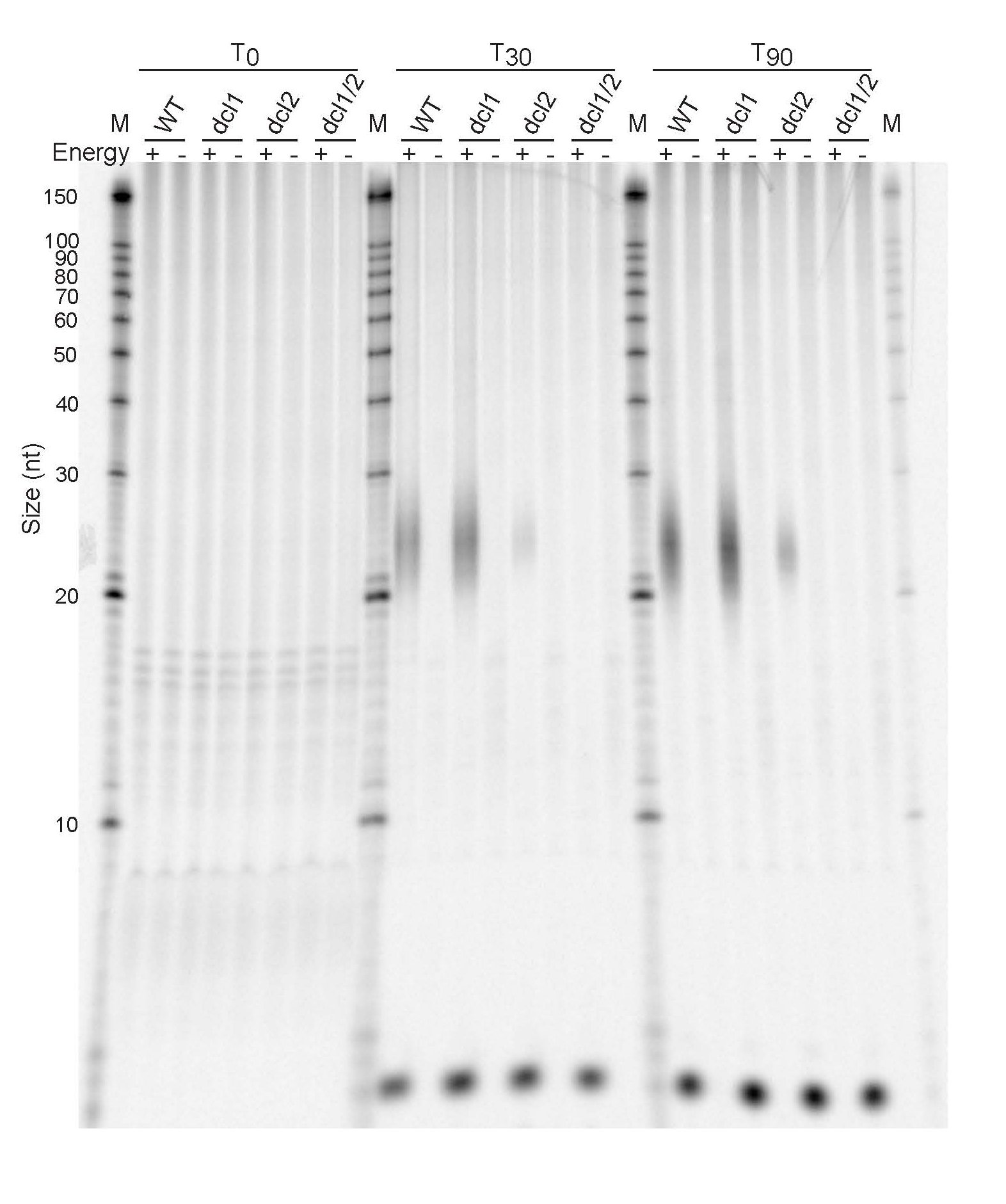A precise size-estimate for the small RNA products arising from Neurospora crassa Dicer activity.
Paul ReFalo and Matthew S. Sachs, Department of Environmental and Biomolecular Systems, Oregon Health & Science University, Beaverton OR 97006-8921
Fungal Genetics Newsletter 51:21-22
Neurospora crassa cell-free extracts prepared from strains containing one or both functional Dicer genes, but not from a strain lacking functional
Dicer genes, converts radiolabeled double-strand RNA (dsRNA) in an energy-dependent manner into short RNAs with an estimated size of ~25-nt (Catalanotto
et al. 2004). A smaller nucleolytic digestion product was also produced in an energy-dependent manner from either dsRNA or single-stranded RNA.
Here we obtained more precise sizes for these products by electrophoresis of samples on a long (40-cm) denaturing DNA sequencing gel (20% polyacrylamide/7M urea).

Fig. 1. Dicer activity in N.crassa single and double mutants for dcl-1 and dcl-2. Analysis of WT, dcl-1, dcl-2 and dcl-1/dcl-2 strains for
Dicer activity was accomplished as described (Catalanotto et al. 2004). N. crassa cell-free extracts were incubated with radiolabeled dsRNA for
0, 30, or 90 minutes (T0, T30, T90) in the presence or absence of an energy regenerating system as indicated, and the RNA was examined by denaturing gel
electrophoresis on a denaturing 20% polyacrylamide sequencing gel. Decade RNA Markers (Ambion) labeled with 32P were used as size standards (lanes marked M).
The data (Fig. 1) show the Dicer- and energy-dependent products obtained from the dsRNA substrate were clustered in a region indicating the
majority of species had sizes between 21-26 nt, with most approximately 23-nt in length. This is consistent with results from other organisms
(Agrawal et al. 2003). An additional very small degradation product was produced in an energy-dependent but Dicer-independent manner.
This product, but not the ~21-26 nt products, was also obtained from single strand RNA (data not shown). Apparently, this small product migrated anomalously
(suggesting a size of approximately ~16-nt) in the shorter gels containing a lower-percentage of polyacrylamide that were used previously
(Catalanotto et al. 2004). Thus, the results in Fig. 1 indicate that, from input dsRNA, N. crassa extracts with Dicer activity produced RNAs of
the size expected to function as small interfering RNA. N. crassa extracts did not contain other activities that processed input RNA into other large
oligonucleotide products.
Acknowledgment. This work was supported by the NIH (GM47498).
References
Agrawal, N., P. V. Dasaradhi, A. Mohmmed, P. Malhotra, R. K. Bhatnagar and S. K. Mukherjee, 2003. RNA interference: biology, mechanism, and
applications. Microbiol. Mol. Biol. Rev. 67: 657-685.
Catalanotto, C., M. Pallotta, P. Refalo, M. S. Sachs, L. Vayssie, G. Macino and C. Cogoni, 2004. Redundancy of the
two dicer genes in transgene-induced posttranscriptional gene silencing in Neurospora crassa. Mol. Cell. Biol. 24: 2536-2545.
Return to the FGN 51 Table of contents
Visit the FGSC homepage
